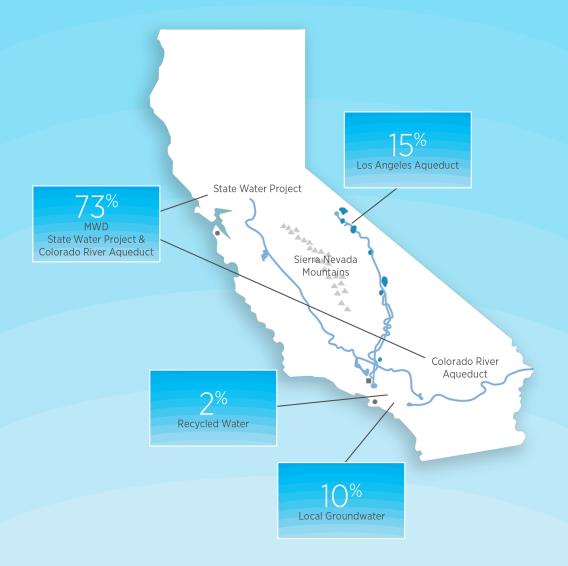Los Angeles receives water from several sources. The Los Angeles Aqueduct (LAA) supplied 15 percent of the water that was treated at the Los Angeles Aqueduct Filtration Plant. Purchased imported water from the Metropolitan Water District of Southern California (MWD) amounted to 73 percent. The remaining amount was sourced from local groundwater at 10 percent and recycled water at 2 percent.
Drinking Water and Your Health

The sources of drinking water (both tap water and bottled water) include rivers, lakes, streams, ponds, reservoirs, springs, and wells. As water travels over the surface of the land or through the ground, it dissolves naturally-occurring minerals and, in some cases, radioactive material. It can pick up substances resulting from the presence of animals or from human activity.
Drinking water, including bottled water, may reasonably be expected to contain at least small amounts of some contaminants. The presence of contaminants does not necessarily indicate that water poses a health risk. More information about contaminants and potential health effects can be obtained by calling the U.S. EPA’s Safe Drinking Water Hotline (800) 426-4791.
Contaminants That May Be Present
Water agencies are required to use the following language to discuss the source of contaminants that may reasonably be expected to be found in drinking water, including tap and bottled water.
Contaminants that may be present in source water include:
- Microbial contaminants, such as viruses and bacteria that may come from sewage treatment plants, septic systems, agricultural livestock operations, and wildlife.
- Inorganic contaminants, such as salts and metals, that can be naturally-occurring or result from urban stormwater runoff, industrial or domestic wastewater discharges, oil and gas production, mining, or farming.
- Pesticides and herbicides that may come from a variety of sources such as agriculture, urban stormwater runoff, and residential uses.
- Organic chemical contaminants, including synthetic and volatile organic chemicals that are by-products of industrial processes and petroleum production, and can also come from gas stations, urban stormwater runoff, agricultural application, and septic systems.
- Radioactive contaminants that can be naturally occurring or be the result of oil and gas production and mining activities.
To ensure that tap water is safe to drink, the U.S. EPA and the State Water Resources Control Board - Division of Drinking Water (SWRCB-DDW) prescribe regulations that limit the amount of certain contaminants in water provided by public water systems. The U.S. Food and Drug Administration regulations and California law also establish limits for contaminants in bottled water that provide the same protection for public health.
Health Advisory for People with Weakened Immune Systems
Although LADWP treats its water to meet drinking water standards, some people may be more vulnerable to constituents in drinking water than the general population. Immuno-compromised persons, such as persons with cancer undergoing chemotherapy, persons who have undergone organ transplants, people with HIV/AIDS or other immune system disorders, some elderly, and infants, can be particularly at risk from infections. These individuals should seek advice about drinking water from their health care providers. U.S. EPA Centers for Disease Control (CDC) guidelines on appropriate means to lessen the risk of infection by Cryptosporidium and other microbial contaminants are available from the Safe Drinking Water Hotline (800) 426-4791.
Chloramines Disinfectant
LADWP has enhanced your drinking water through the use of chloramines, which helps maintain a higher level of quality and safety as it journeys all the way to your tap. However, customers who have unique water quality needs or use specialized equipment, such as dialysis machines, should make necessary adjustments to remove chloramines. If you maintain a fish pond, tank, or aquarium, adequate treatment must be provided to remove chloramines, as they can be harmful to fish. For more information, please visit www.ladwp.com/waterquality or call (213) 367-3182.